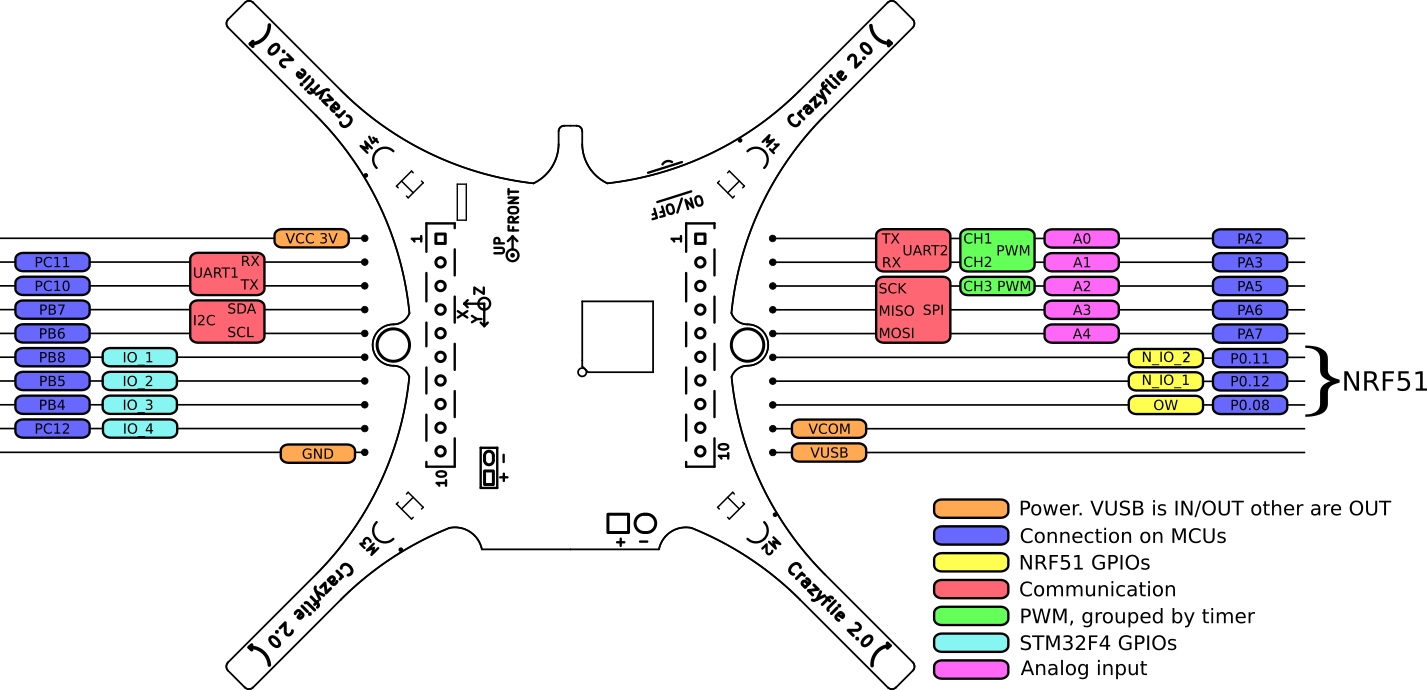Crazyflie 2.1+ is a flying development platform open source, versatile and ultralight, weighing only 29g, compact enough to fit in the palm of one hand.
Crazyflie 2.1+ features low-latency, long-range radio, as well as Bluetooth LE support. This allows you to download the app and directly use your smartphone as a radio control or, in combination with the Crazyradio 2.0, employ your computer to view flight data and pilot via a game controller.
This new version, an evolution of the successful Crazyflie 2.X platform, incorporates an updated battery and propellers, providing up to 15 percent improvement in flight performance. With its vast ecosystem of software and expansion boards (decks), it is an ideal choice for training, research and swarming (swarming) flight applications.
Features
- Rugged and durable design
- Easy to assemble, with no soldering required
- Supports expansion decks with automatic detection
- Compatible with flying via iOS and Android via Bluetooth LE, as well as from Windows/Mac OSX/Linux with Crazyradio, Crazyradio PA, Crazyradio 2.0
- Tested with radio range up to over 1 km line-of-sight (LOS) using Crazyradio PA
- Wireless firmware updates
- Integrated charging via standard micro-USB connector
- Dual-MCU architecture with dedicated SoC for radio and power management, for advanced applications
- Real-time data recording, variable graphics and configuration, with full support for expansion decks when used in conjunction with Crazyradio, Crazyradio PA or Crazyradio 2.0 and a computer
How it works
Crazyflie 2.1+ is an extremely versatile open source aerial development platform that weighs just 29g and fits in the palm of one hand.
It is not only a great microdrone: Crazyflie 2.1+ features low-latency and long-range radios, as well as Bluetooth LE support. This allows you to download the dedicated app and immediately start testing and flying using your mobile device. For a more complete experience-including access to advanced features, data visualization, and extended control-we recommend connecting via computer in combination with Crazyradio 2.0 or Crazyradio PA, and using a game controller or custom scripts.
Version 2.1+ of the established Crazyflie 2.x development platform incorporates an improved battery and propeller set, providing up to a 15 percent increase in flight performance. Together with an extensive ecosystem of software and expansion modules (decks), it proves an ideal choice for teaching, research and swarm applications.
Use
Crazyflie 2.1+ was designed to be as flexible as possible. This meant integrating as many features as possible and developing firmware designed to be modified.
In addition to the default functions of Crazyflie 2.1+, a flexible expansion interface was added that allows various expansion decks to be attached to both the top and bottom of the drone. Through this interface, the user can access buses such as UART, I2C and SPI, as well as PWM, analog inputs/outputs and GPIO.
Getting Started
Visit Crazyflie 2.x's "Getting Started" tutorial to assemble your drone, update the firmware, and start flying with the various clients. Also check out the System Overview to learn more about the Crazyflie ecosystem, which includes positioning systems, clients, and of course Crazyflie itself with its expansion modules.
Development
A development platform must offer more than just access to code. For this Bitcraze software, firmware, and utility tools include features such as logging, real-time parameter setting, and wireless firmware updates.
The complete development environment for most subsystems is available in a virtual machine, so there is no need to install toolchains to start development. The virtual machine also works perfectly for flight.
Once the changes are made, just flash the new firmware over the radio and you are ready to fly. For those interested in more advanced development, a development adapter kit is available that allows easy JTAG/SWD connection to both microcontrollers of the Crazyflie 2.1+.
Open Source
Crazyflie 2.1+ is a project open source, with source code and hardware schematics documented and available, as all Bitcraze development tools are open source (except for iOS). In addition to firmware and software projects, there are numerous APIs supported by community, written in Java, Ruby, C/C++, C# and Javascript.
Modifying code
There are many possibilities for experimenting with code, regardless of the preferred language. The Bitcraze API client is written in Python, but many client-side implementations are available on GitHub in Ruby, C#, C/C++, JavaScript, Node.JS, Cylon.JS, or Java. Alternatively, you can clone the iOS repository and work in Objective-C/Swift.
For those working with embedded systems, the STM32F405 offers ample computing resources to leverage for experiments, improvements, and new features. In addition, expansion decks allow you to experiment, prototype, and design your own hardware.
Expansion connector specifications
The expansion connector is used to connect decks with additional functionality. You can either use official Bitcraze expansion decks or design your own with the KiCad template.
The expansion connector includes:
- VCC 3.0V (max 100mA)
- GND
- VCOM (VBAT or VUSB unregulated, max 1A)
- VUSB (both input and output)
- I2C (400kHz)
- SPI
- 2 x UART
- 4 x GPIO/CS for SPI
- 1-wire bus for deck identification
- 2 x GPIO connected to nRF51
Important Notes:
- The Crazyflie 2.1+ is a 3.0V system: a high output will be 3.0V, but remains compatible with 3.3V systems.
- All I/O pins are 5V tolerant, with the exception of PA5 and the NRF51 pins.
- The NRF51 pins can be multiplexed with any peripheral available on the chip.
- STM32F405RG pins can be multiplexed with additional functions.

The package contains: 1 x Crazyflie 2.1+ - Bitcraze.
Specifically, the kit includes:
- 1 x Crazyflie 2.1 control board.
- 1 x 250mAh LiPo Battery
- 5 x 7mm coreless DC motors
- 6 x 7mm motor mounts
- 1 x Battery foam pads
- 5 x CCW Propellers
- 5 x CW Propellers
- 1 x Battery holder deck
- 2 x Short male connectors for deck
- 2 x Long male connectors for deck
- 1 x Micro-USB cable (48 cm)